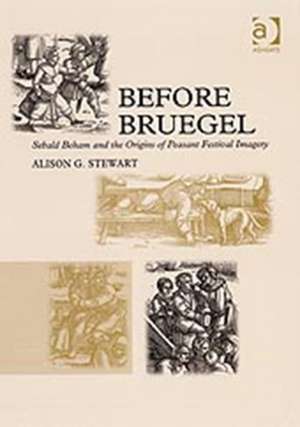Before Bruegel: Sebald Beham and the Origins of Peasant Festival Imagery
Autor AlisonG. Stewarten Limba Engleză Hardback – 7 iul 2008
Preț: 775.61 lei
Preț vechi: 1109.49 lei
-30% Nou
Puncte Express: 1163
Preț estimativ în valută:
148.43€ • 154.39$ • 122.54£
148.43€ • 154.39$ • 122.54£
Carte tipărită la comandă
Livrare economică 14-28 aprilie
Preluare comenzi: 021 569.72.76
Specificații
ISBN-13: 9780754633082
ISBN-10: 075463308X
Pagini: 384
Dimensiuni: 174 x 246 mm
Greutate: 1.09 kg
Ediția:1
Editura: Taylor & Francis
Colecția Routledge
Locul publicării:Oxford, United Kingdom
ISBN-10: 075463308X
Pagini: 384
Dimensiuni: 174 x 246 mm
Greutate: 1.09 kg
Ediția:1
Editura: Taylor & Francis
Colecția Routledge
Locul publicării:Oxford, United Kingdom
Cuprins
Contents: Preface; Introduction; The beginning of peasant festival imagery: Sebald Beham and the reform of festivals in Nuremberg; Secular celebration and reform: The Large Kermis; Reading kermis: kermis prints with text; Sizing up at kermis: the Nose Dance; Celebrating and reforming marriage: the Peasant Wedding Celebration; Celebrating and reforming gender: the Spinning Bee; Distributing prints: woodcuts and their audience; Establishing a market for peasant festival imagery: from Beham to Bruegel; Conclusion; Appendix; Bibliography; Index.
Notă biografică
Alison G. Stewart is Professor of Art History at the University of Nebraska-Lincoln, USA, where she teaches Medieval and Northern Renaissance Art.
Recenzii
�... Stewart deftly inserts her material into a number of significant art historical and interdisciplinary debates while making a series of clearly articulated and interrelated arguments pertaining especially to the reception of Sebald Beham's peasant festival woodcuts... in drawing our attention once again to Sebald Beham and in contextualizing his work in new ways, Stewart makes a convincing case, especially for her colleagues, that the career and production of this artist and entrepreneur are worthy of further analysis.� Historians of Netherlandish Art �The author seamlessly integrates commentary from multiple sources - pamphlets, plays, legislation - with close readings of the various editions, states, and copies of peasant festival woodcuts to create for the reader an overall sense of the cultural contexts within which Beham�s images were viewed.� Caa.Reviews '... the author has offered us a successful model of research on a variety of cultural objects, which one hopes may stimulate research on other fields of our heritage still awaiting further investigation.' Imago Musicae
Descriere
Peasant festival imagery began in sixteenth-century Nuremberg, when the city played host to a series of religious and secular festivals. The peasant festival images were first produced as woodcut prints in the decade between 1524 and 1535 by Sebald Beham. In Before Bruegel, Alison Stewart takes a fresh look at these images and explores them within their historical and cultural contexts, including the introduction of the Lutheran Reformation into the town's institutions and the accompanying re-evaluation of the town's popular festivals.



